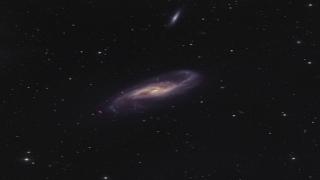Bibcode
Williams, D. R. A.; McHardy, I. M.; Baldi, R. D.; Beswick, R. J.; Pahari, M.; Argo, M. K.; Beri, A.; Boorman, P.; Brinks, E.; Dullo, B. T.; Fenech, D. M.; Ineson, J.; Kharb, P.; Knapen, J. H.; Muxlow, T. W. B.; Westcott, J.
Referencia bibliográfica
Monthly Notices of the Royal Astronomical Society, Volume 486, Issue 4, p.4962-4979
Fecha de publicación:
7
2019
Número de citas
8
Número de citas referidas
7
Descripción
We present high-sensitivity 1.51 GHz e-MERLIN (e-Multi-Element
Radio-Linked Interferometer Network) radio images of the nearby galaxy
NGC 6217. We resolve the compact radio source at the centre of NGC 6217
for the first time, finding a twin-lobed structure with a total linear
size of ˜4 arcsec (˜400 pc). The radio source does not have
a compact central core, but there is an unresolved hotspot near the
outer edge of the southern lobe. Combining our e-MERLIN data with new
VLA (Very Large Array) A-Array data and archival multiwavelength data,
we explore possible scenarios which might explain this complex radio
morphology. We conclude that this radio source is most likely powered by
a low-luminosity active galactic nucleus but with a possible important
contribution from nuclear star formation. We also investigate the origin
of a putative X-ray jet in NGC 6217, previously suggested in the
literature. This `jet' consists of three X-ray `knots' in a line,
pointed away from the nucleus, with a total size of ˜3 arcmin
(˜15 kpc). We find no extended radio emission coincident with the
`jet'. An additional compact radio source, aligned with the knots but
without an X-ray counterpart is detected. We detect infrared/optical
sources falling within the X-ray extraction regions of the `knots', but
note that these sources could be chance associations due to high source
density around the target field and we estimate the probability of three
randomly aligned X-ray sources to be 0.3 per cent in this field.
Proyectos relacionados

Las Galaxias Espirales: Evolución y Consecuencias
Nuestro grupo pequeño esta bien conocido y respetado internacionalmente por nuestro trabajo inovativo e importante en varios aspectos de la estructura y la evolución de las galaxias espirales cercanas. Usamos principalmente observaciones en varias longitudes de onda, explotando las sinergías que nos permiten responder a las cuestiones más
Johan Hendrik
Knapen Koelstra